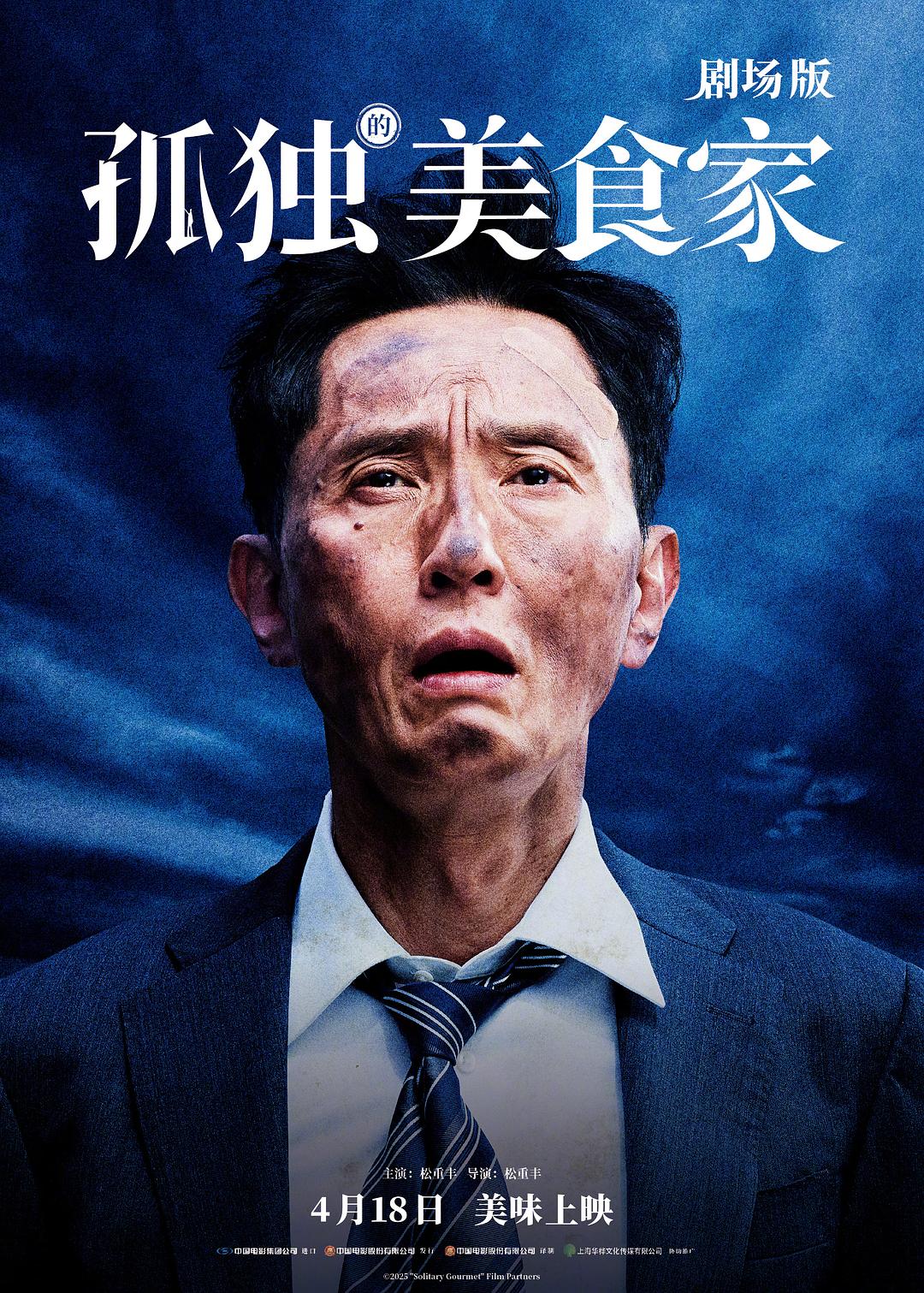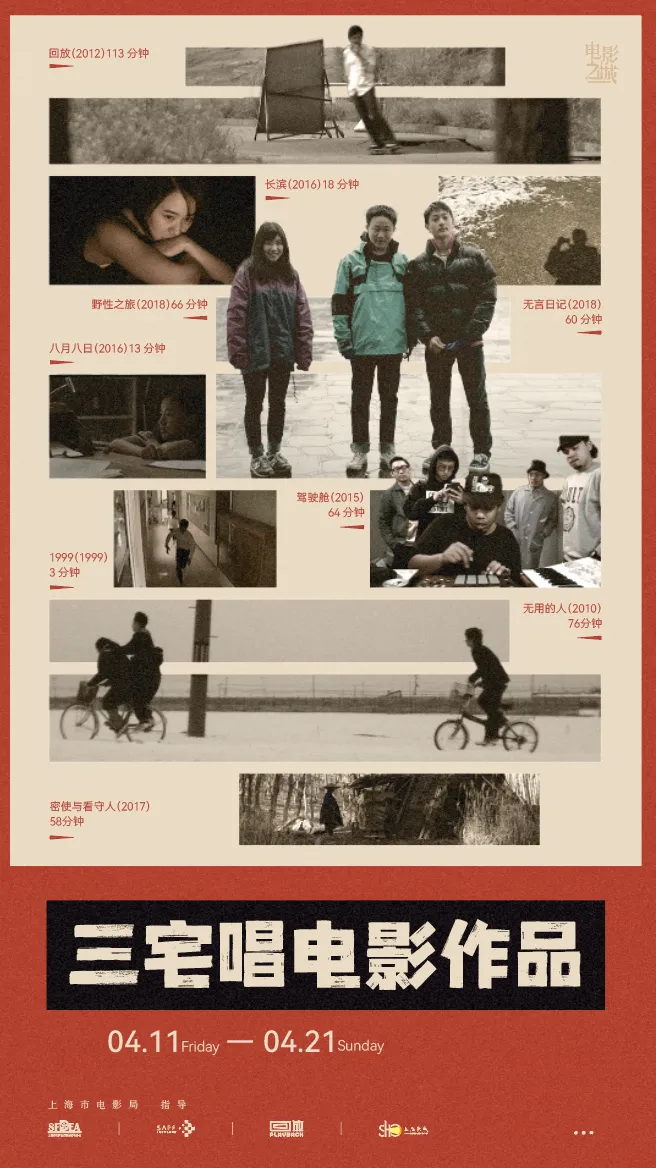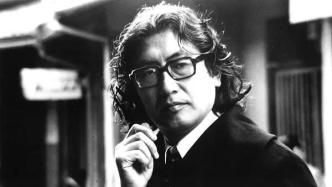
At 3:25 pm on January 15, 2013, Nagisa Oshima died of pneumonia at the hospital in Fujisawa City, Kanagawa Prefecture at the age of 80. Today in 2023 is the tenth anniversary of his death.
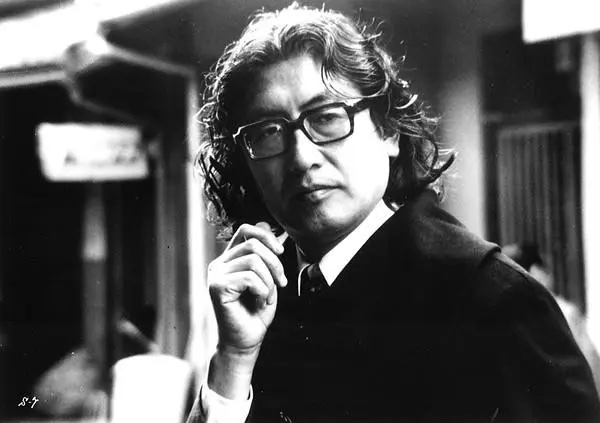
Oshima Nagisa
In order to commemorate this standard-bearer of the Japanese New Wave film, a figure that is difficult to bypass in the history of world film, The Paper interviewed Zhi Feina, a professor at the Chinese Academy of Arts, a member of the National Film Think Tank, and a distinguished researcher at the University of Tokyo.
【dialogue】
In Tokyo, Nagisa Oshima established a second "Creation Society"
The Paper: Did you meet director Nagisa Oshima when you were studying in Japan? Talk about your experience, intuitive feelings and scholarly thinking when you came into contact with Nagisa Oshima's films?
Zhi Fina: Oshima Nagisa is a world-renowned Japanese film master. He once said, "It is great happiness to have a director like me in this world." You will find that it is rare for people who dare to say this sentence without being questioned and ridiculed. I was too young to get to know Nagisa Oshima himself.
In February 1996, Nagisa Oshima was entrusted by the Japan International Exchange Fund under the Ministry of Foreign Affairs of Japan to go to the UK to spread Japanese film culture. When he was about to return home, he suffered a cerebral hemorrhage on the car to the airport. Since then, he has resumed training with tenacious perseverance, and in 1999 he completed the costume film "Yu Fa Du".
Since his duodenal ulcer perforated in 2002, he has been paralyzed and bedridden, and his body has gradually lost control. His wife, Akiko Koyama, takes good care of him. In May 2010, Akiko Koyama accepted my interview for him and told me where Nagisa Oshima’s grave is. As the director's health deteriorates, the family has prepared for his death.
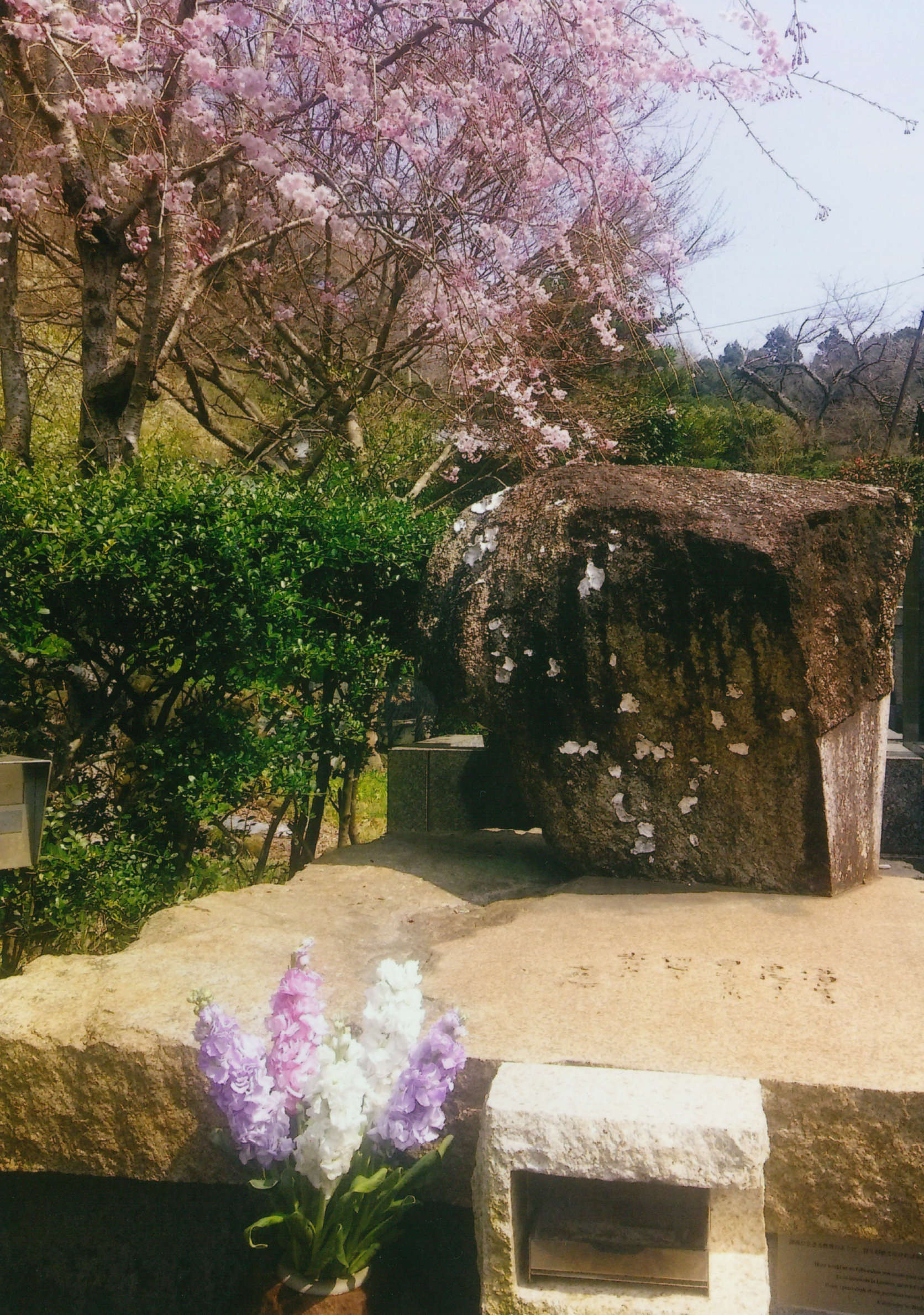
Nagisa Oshima's tomb at Kenchoji Temple in Kamakura, Kanagawa Prefecture, Japan. Nagisa Oshima's favorite poem is engraved on the pedestal, "People are like deep-sea fish. If you don't shine, you will be surrounded by darkness." (Photo courtesy of Akiko Koyama)
I paid attention to Nagisa Oshima in 2002. The topic of my master's thesis was "Research on the Aesthetics of Japanese New Wave Films." Of course, many of Nagisa Oshima's works are many school film and television majors' exam preparation films. In addition to "The World of the Senses", "Love's Bullfighting" and "Merry Christmas on the Battlefield", many works such as "Cruel Story of Youth" and "Max, My Love" have long been classic teaching films of the Beijing Film Academy. . Therefore, during the research process, I was able to quickly form a discussion atmosphere with my teachers and classmates about Nagisa Oshima.
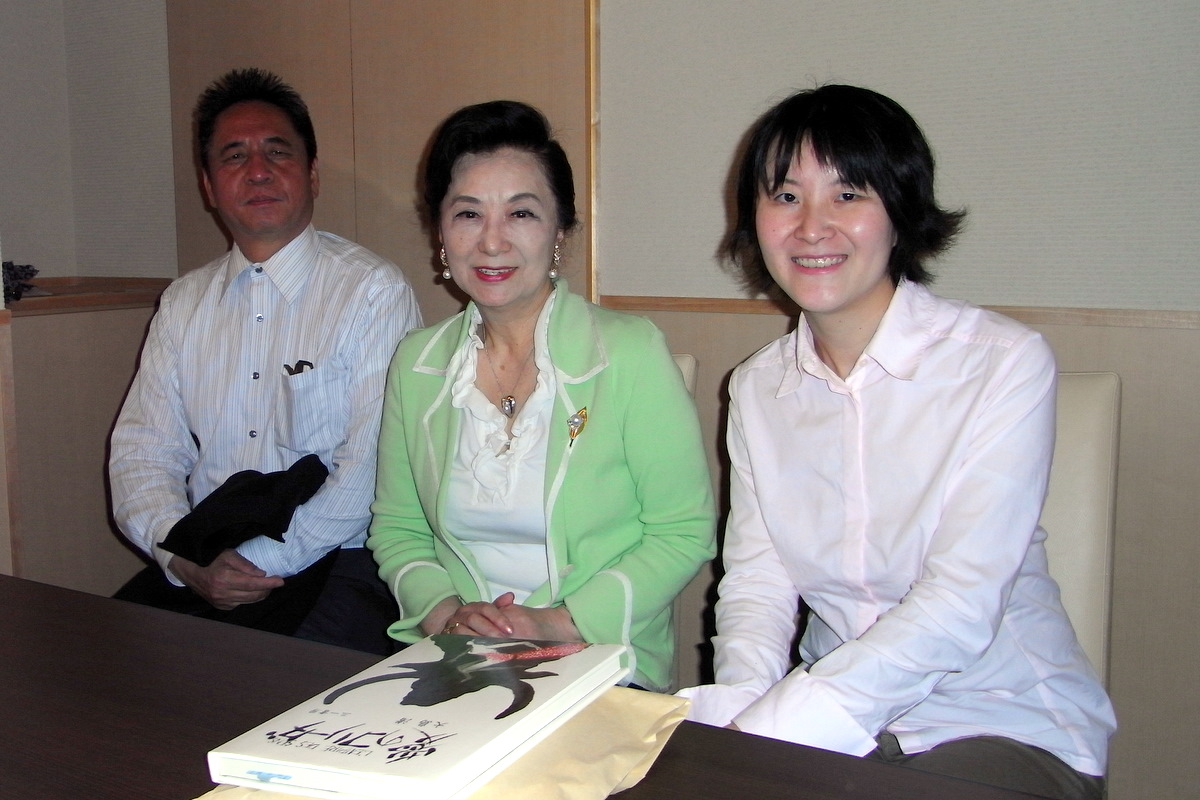
In June 2010, Zhi Feina interviewed Akiko Koyama. From the left are the producers of "Merry Christmas on the Battlefield" Masaoyuki Motochi, Akiko Koyama and Fina Zhi (photo provided by Fina Zhi)
After graduating from a master's degree, in my contacts with many Japanese filmmakers, I often paid attention to the influence of Nagisa Oshima on them or their evaluation of Nagisa Oshima. Regardless of reputation in the eyes of critics or the public. Frankly speaking, in terms of peer evaluation alone, famous directors such as Yasujiro Ozu, Mikio Naruse, Akira Kurosawa, and Keisuke Kinoshita always have mixed reputations during their lifetime. But Nagisa Oshima is different. No matter what generation of Japanese filmmakers, Nagisa Oshima is a character that is difficult to get around. As Kiyoshi Kurosawa said, "Oshima Nagisa is at the pinnacle of modern representative Japanese directors."
The Paper: How did you receive the news on the day Nagisa Oshima passed away on January 15, 2013? Recall the domestic and international reactions to the director's death at that time?
Zhi Fina: The news of Nagisa Oshima's death and funeral has been widely reported by the Japanese media. His funeral was held at Tsukiji Honganji Temple in Tokyo, Japan, and more than 700 relatives, friends and colleagues in the film and television industry came to see him off. Takeshi Kitano and Ryuichi Sakamoto carried the coffin, and the farewell music was the theme song composed by Ryuichi Sakamoto for the movie "Merry Christmas on the Battlefield". The friends who saw us off at the scene told me that the venue of Honganji Temple is very large, so the see-off team of more than 700 people still seemed a bit bleak.
After the news of Nagisa Oshima's death was made public in Japan, I learned the news from the website and sent a letter of condolence to Akiko Koyama. Generally speaking, social media was not as developed as it is now in 2013, but there are still many literary and art lovers in China who know director Nagisa Oshima, so there are many voices of mourning. Hong Kong film critics Shu Qi and Cai Lan also spoke out. I once wrote an article saying, "In this era of masters dying and masters going to die, after Nagisa Oshima, there are no more masters in the Japanese live-action film industry."
The Paper: Nagisa Oshima was born in Kyoto and grew up in Okayama County until he was 6 years old. Because of his father's early death, he followed his mother to his grandmother's house in Kyoto. After graduating from Kyoto Municipal Luoyang High School (currently Kyoto Municipal Luoyang Technical High School), he entered the Faculty of Law of Kyoto University. During his university studies, he studied under Masamichi Inoki. Served as the chairman of the Kyoto Prefectural Federation of Students, and failed the assistant examination of the Faculty of Law. He came from a legal background, what conditions and vision does this provide for him to work as a director in the future?
Zhi Fina: Nagisa Oshima's father died young, but the red books such as "Das Kapital" hidden by his father at the risk of death had a great influence on Nagisa Oshima. He has been highly sensitive to politics and society since he was a child. Nagisa Oshima's mother is strict in educating her children, and she hangs the doorplate of "Nagi Oshima" on the door of the house, making him the head of the family at the age of 6, so he has an independent and self-loving personality.
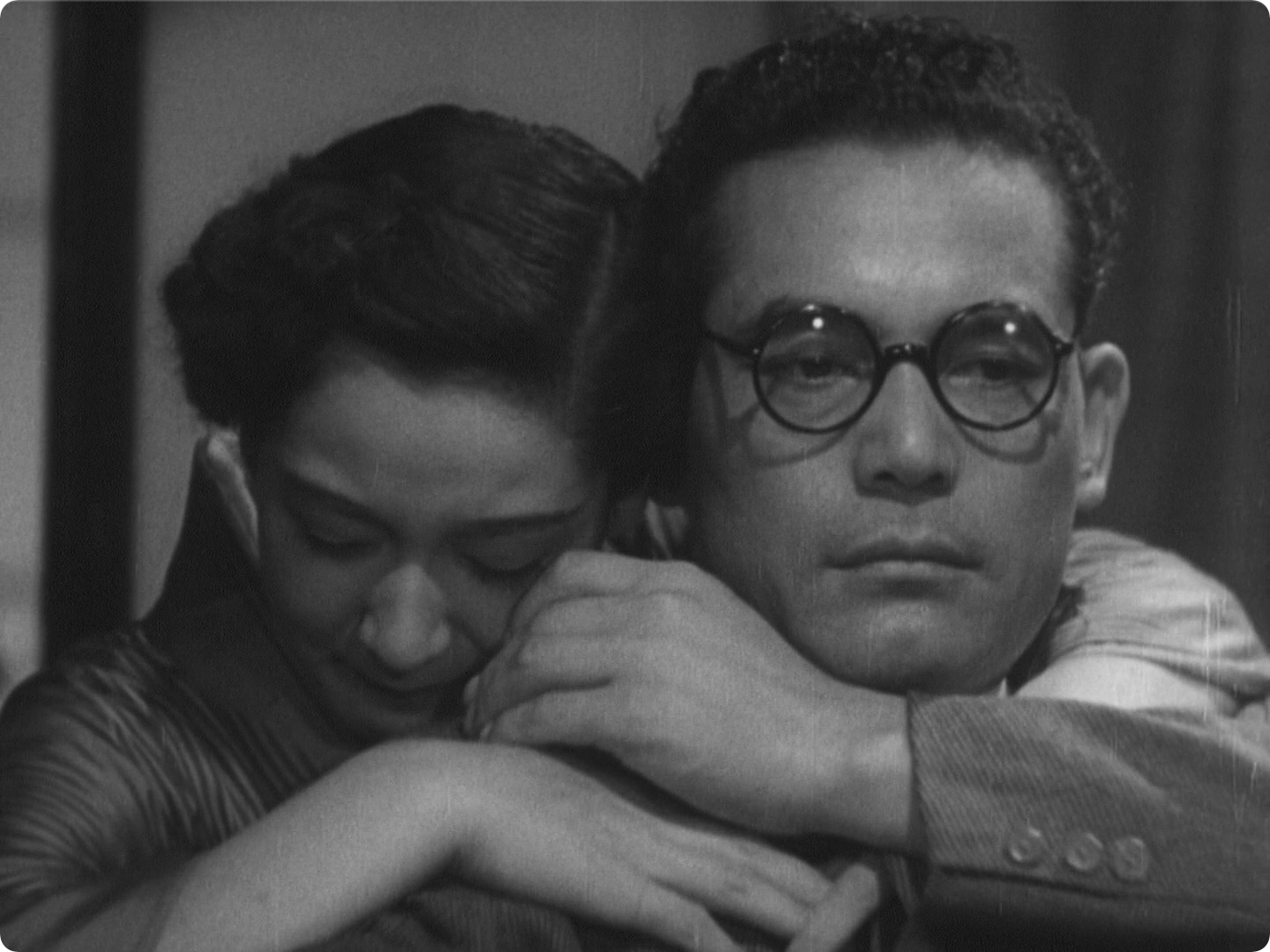
Screenshot of "My Youth Without Regrets"
In 1946, Nagisa Oshima, who was in the third grade of junior high school, accidentally watched "My Youth Without Regrets" (わが青春に恨なし) directed by Akira Kurosawa. Professor Yagi, the soul of the film, is based on Yukito Takigawa, a professor at the Faculty of Law at Kyoto University. In 1933, Yukito Takigawa criticized in his book that the "crime of adultery" only applies to women, pointing out that "all crimes come from the evil of the state organization", and was dismissed by the militaristic government as a redist , causing all 31 faculty members of the Faculty of Law to resign in protest. This is the famous "Beijing University Incident" in history.
The protagonist of the film, Noma, is based on Lu Xun's friend and Asahi Shimbun reporter Hidemi Ozaki. During the Second World War, the spy team with the superstars Richard Sorge and Ozaki Hidemi as the core provided the Soviet Union with a large amount of key information on the movements of the Axis countries in Tokyo, thus affecting the process of the World War II. Ozaki Hidemi's public identity is an expert on China issues, private secretary and advisor to Prime Minister Konoe Fumimaro, who was once based in Shanghai, and had in-depth contacts with Smedley that surpassed friendship. In 1941, Hidemi Ozaki and Sorge were arrested and sentenced to death.
The famous "Ozaki-Sorge Incident" in the history of espionage had a profound impact on Japanese intellectuals. "My Youth Without Regrets" encouraged a young boy from a difficult family, Nagisa Oshima, to apply for the Faculty of Law of Kyoto University, and he was admitted in 1950, majoring in political science and political history, and minoring in French.
In Japan, there are several directors with a legal background, the more representative ones are Nagisa Oshima and Yoji Yamada. Nagisa Oshima said, "I have forgotten all the legal provisions, but I have kept in mind only the nine articles of the Constitution (Note: the Peace Constitution) and Article 175 of the Criminal Law on the crime of distributing obscene materials." That makes him a model for dealing with the legal issues surrounding "The Kingdom of the Senses."
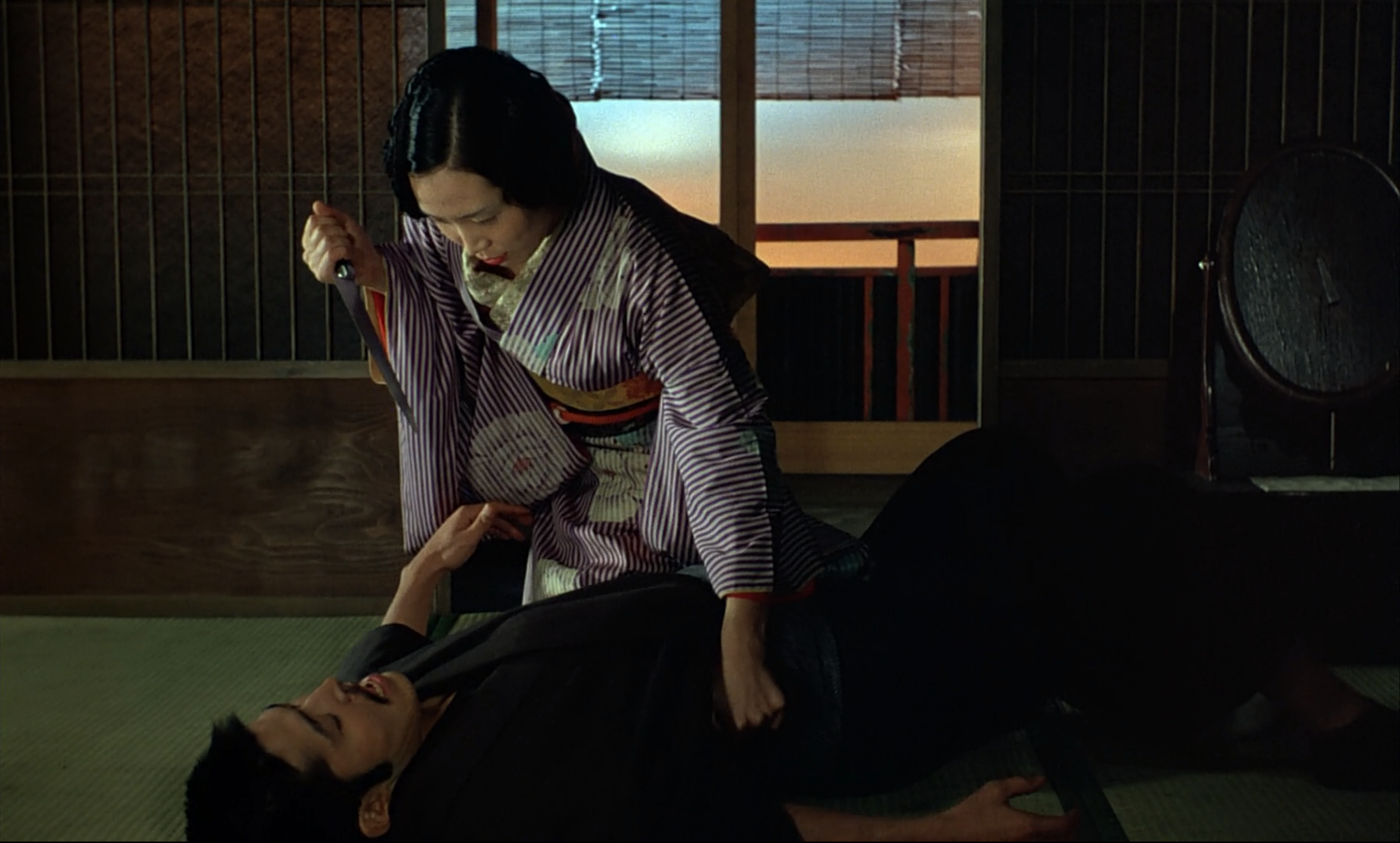
Stills of "The Kingdom of the Senses"
The Paper: So, I would like to advance the following question. Was Nagisa Oshima's famous work "The Kingdom of the Senses" allowed to be filmed in Japan at the time? I want to talk about my viewing experience. I watched it in college. To be honest, he made me feel confused and afraid of women and men and women for a while. Of course, I can see the folk customs and anti-war in it... For such a movie, the director and actors will undoubtedly have to pay a lot. Blood and sacrifice.
Zhi Fina: In the Japanese film classification environment at that time, it was illegal to shoot a film like "The Kingdom of the Senses". Therefore, in 1975, after receiving a production invitation from France, Oshima Nagisa deliberately adopted the "French customization" model to complete "The Kingdom of the Senses". That is to say, the film is shipped from France, and the raw film is not developed after shooting (term: refers to the rough cut film material), and it is directly sent back to France for development and editing after being sealed as it is. According to Japanese law, this belongs to "processing with supplied materials", and it only needs to be reported to the customs normally, and there is no need to undergo content review. But the difficulty in doing this is that I haven’t seen the raw film (referring to the rough cut film material), so I can’t decide whether to reshoot.
Nagisa Oshima is still proud of his talents. "Kingdom of the Senses" was completed in one go. After the filming was completed in December 1975, the film was shipped back to France. It was developed in France in January 1976, and Nagisa Oshima went to France for editing in February. In May, when it was screened in Cannes, the audience was empty. It was evaluated as "discovering the tradition of sexual praise in traditional Japanese common people culture, and challenging the European society that has long been suppressed by religion due to sexual repression."
The second is to deal with litigation. Oshima Nagisa published the book "The Kingdom of the Senses" in June 1976. In addition to the film script and other text, he also published 25 large-scale stills. Therefore, he and the publisher were prosecuted for the crime of "distributing obscene materials". During the court session, in the face of the prosecutor's accusation of "obscenity", Nagisa Oshima carefully defended his innocence: Article 175 of the Japanese Criminal Code (the crime of distributing obscene objects) is unconstitutional. In the end, the verdict of the first instance was not guilty. The verdict of the second instance was not guilty. In June 1982, the Tokyo High Court acquitted Nagisa Oshima, and the six-year lawsuit came to an end.
The Paper: Nagisa Oshima studied in Kyoto, and the name of Kyoto has elements of Tang Chang'an and Luoyang. Does he know and love Chinese culture or not? Is there any introduction?
Zhi Feina: Nagisa Oshima is very concerned about China, but not because Kyoto is a copy of Luoyang or Chang'an.
Nagisa Oshima never forgot to set his sights on China. In this regard, Japanese film scholar Inuhiko Shikata has related research results: How significant is China to Nagisa Oshima? To understand this point, it can be traced back to his original intention of naming it "Creation Society" without hesitation when he fired Shochiku in 1961 and established an independent production company. The name "Creation Society" is of great significance in the history of Chinese revolutionary literature. This is the name of the literary group formed in 1921 by Guo Moruo, Yu Dafu, Tian Han and others during their study in Fusang. 40 years later, in Tokyo, Nagisa Oshima founded his second "Creation Society" in hopes of realizing his long-cherished wish of revolutionizing Japanese film art.
From 1964 to 1965, Nagisa Oshima's Creation Agency completed the production of the TV series "Dawn of Asia". The protagonist is a Japanese young man who was admitted to the Japanese Army Non-commissioned Officer Academy. He has a close relationship with the Qing Dynasty students in the school, and he is even more excited to know the demeanor of Sun Wen, who is in exile in Japan. After the Revolution of 1911, overseas students returned home one after another to devote themselves to the revolution. The protagonist also dropped out of the Army University and went to Shanghai to reunite with his former classmates. After resuming his friendship, he began to think about how he could contribute to the Chinese revolution. "The Dawn of Asia" has received less attention in Nagisa Oshima's works, but it is an indispensable work in understanding his views on China and modern East Asian history.
In 1968, Nagisa Oshima completed the TV documentary "The Great East Asian War". In 1969, the TV documentary "Mao Zedong: His Career and the Cultural Revolution" was completed. In 1976, shortly after the death of Chairman Mao, Nagisa Oshima completed the TV documentary "Biography of Mao Zedong". He also served as a judge of the Shanghai International Film Festival, and he did not hesitate to support and pay attention to Chinese films. As far as I know, Li Ying, a Chinese director in Japan who made the documentary film "Yasukuni Shrine", also received a lot of care and guidance from director Nagisa Oshima.
Never turning to big business, never repeating himself, "His work is always highly political and social"
The Paper: In 1954, Nagisa Oshima joined Shochiku after graduating from Kyoto University and worked as an assistant director at Shochiku Ofuna Studio. With masterpieces such as "Cruel Story of Youth" and "The Graveyard of the Sun" (1960), he became a representative of Shochiku's new generation of directors. Please introduce the history of Shochiku Studios and its status in the Japanese film industry?

Stills of Graveyard of the Sun
Zhi Feina: Shochiku Film Company is an important center of Japanese film industry. Several times of Japanese film industry innovation and artistic innovation in history came from Shochiku Film Company. It is still the second largest film company in Japan to this day. Before World War II, it had representative Japanese directors such as Yasujiro Ozu, Mikio Naruse, and Keisuke Kinoshita under its umbrella. After World War II, a large number of outstanding young people were gathered through recruitment, including later Nagisa Oshima, Shohei Imamura, and Masahiro Shinoda. The more famous aesthetic feature of Shochiku's films is the "Shochiku Onsen style", or "Sentimentalism", that is, urban family ethics dramas or warm and sentimental popular dramas. And this is what Oshima Nagisa is extremely opposed to.
Surging news: Nagisa Oshima made his debut in the film industry from "The Cruel Story of Youth". What are the characteristics of this film, and what ideas and tendencies does it indicate in the future of the director?

Stills of "Cruel Story of Youth"
Zhi Fina: In 1955, Nagisa Oshima became the assistant director of Shochiku Company, which coincided with the short golden period when Japanese films were at their peak both in terms of production and screening. After Nagisa Oshima made his debut in 1959, he completed the youth film "Cruel Story of Youth" in June 1960. The film shows the life trajectories of two young men and women whose youth was frustrated and their thoughts gradually became decadent due to the failure of political activities, which was highly compatible with the social atmosphere at that time. When the film was premiered and promoted, it was dubbed the "New Wave of Japanese Film" by the Japanese "Yomiuri Weekly". It can be said that from this film onwards, his most typical creative tendencies have been running through - first, his works are always highly political and social. The second is related to violence and sexual expression.
The Paper: In 1960, in order to protest the "security struggle" against the revision and approval of the "U.S.-Japan Security Treaty" as the stage, the work "Night and Fog in Japan" was suspended from screening and withdrew from Shochiku. In this regard, can the director be defined as one of the Japanese New Leftist film directors?
Zhi Fina: I have never seen the term "New Left" in Japanese movies. As a film author, Nagisa Oshima has broken the stereotypes of every imaginable film-making system, and has left his own footprint in every breakthrough. It can be said that his works have the meaning of "meta-film". That is to say, no matter at which creative stage you encounter a bottleneck, you can go to see how Nagisa Oshima shoots, and you can get inspiration.

Stills of "Royal Law"
Nagisa Oshima completed a total of 24 feature films, 23 (aired) TV documentaries and some film commercials from his debut film "The Street of Love and Hope" in 1959 to "The Royal Law" in 1999. Each of his works is not repeated.
Many directors repeat themselves all their lives, especially with their debut feature. But as Shikata Inuhiko said, it is difficult for you to sum up Nagisa Oshima's creations in one word. Oshima Nagisa has varied and colorful styles throughout his life, and each style is close to the extreme. He tried his best to pursue the critical point of each style that is full and about to collapse, but he did not stick to it at all. He immediately devoted himself to creating another style in the next work. A directorial style and editing order. Many people have been avoiding the study of Nagisa Oshima because they cannot grasp the overall appearance of Nagisa Oshima's aesthetic style. But now, with the development and iteration of world movies, young Chinese audiences don't know much about him. In fact, besides being a filmmaker, he is also a writer and translator. Even when he was bedridden, he continued to write. He not only wrote the book "Oshima Nagisa 1968", but also translated four books including "The Book of Deep Love" by psychologist John Gray. Typical "life is endless, fighting is endless".

Stills of "Japanese Spring Song Test"

"Ritual" stills
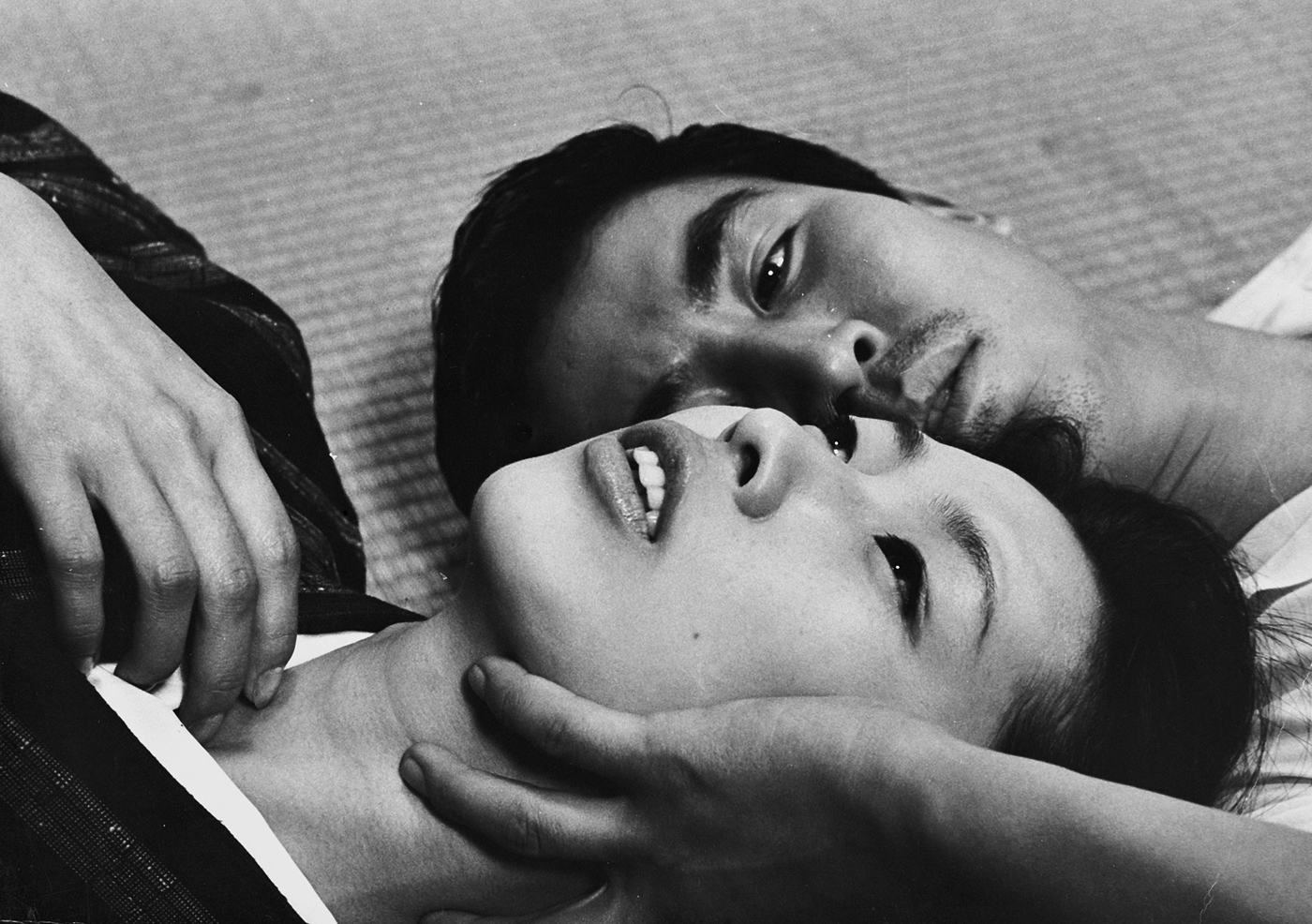
"Joy" stills
Surging News: Returning to Nagisa Oshima's directorship, many of his works, including the highly controversial "Abe Sada Incident" adapted from a real Japanese criminal case (Abe, as a mistress, cut off her boyfriend's penis after strangling her to death) The Kingdom of the Senses (1976). What controversies were there? What influence did it have on later generations of directors, such as "Farewell My Concubine" and "Kill Me Softly" directed by Chen Kaige, I think it was also influenced by this film?
Zhi Fina: Nagisa Oshima is the first filmmaker in the world to successfully combine hard pornography with politics and art.
The "Sada Abe Incident" that actually happened in 1936 tells the story of the extreme sex between Sada Abe, a hostess at a hotel, and her employer, Ji Zang. In reality, Jo Abe was brought to court for homicide and destruction of remains, and was sentenced to six years of servitude. Many Japanese film directors are very concerned about this subject. When Nagisa Oshima took the script of "The Kingdom of the Senses" to persuade Director Wakamatsu Koji to be his producer, in fact, Wakamatsu Koji himself was also planning to shoot "Abe Sada Incident". There is also a film in later generations called "Shilu Abe Sada". In "Paradise Lost" starring Kuroki Hitomi, the work of the actor Koji Yakusho is also related to the Abe Sada incident.
Akiko Koyama once told me that before "The Kingdom of the Senses", there had never been so many directors who came to care about Nagisa Oshima's films. After the sensation at the Cannes International Film Festival in 1976, "The phone at home kept ringing, and they condescended to ask, Director Oshima, how did you make that film? Where can I see it?"
Nagisa Oshima believes that "film directors like to shoot two kinds of things, one is the process of death, and the other is the relationship between men and women". Many of his previous films have shown the relationship between men and women from multiple angles. In 1975, Nagisa Oshima received funding from France and planned to use French funds to shoot a peachy movie set in Japan. But on April 26, 1975, France fully lifted the ban on pornographic films, and pornographic films bloomed everywhere at the Cannes International Film Festival, and many directors even starred in themselves. Word came that he was determined to take on "hard" porn. Then came the "Kingdom of the Senses", which "extends the ultimate sexual expression, that is, the expression of copulation itself".

"Merry Christmas on the battlefield" stills
The Paper: In my opinion, "Merry Christmas on the Battlefield" is an alternative "Military Paradise". It surpasses the reflections on war and Eastern and Western cultures in "The Bridge on the River Kwai" (1957) from the perspective of male behavior and emotion. ——Samurai sword and cross, shame culture and guilt culture. There are three mirror images in the film, Jin Yuan and De Yang, Yuan Xuanwu and Lawrence, Yu Jing and Cyrils, please analyze?
Zhi Fina: "Merry Christmas on the Battlefield" describes the exchanges and conflicts between Japanese soldiers and British prisoners in Java during the war. This film doesn't just look at male homosexuality. Sifang Tian Inuhiko also used the concept of "homosocial", which means that between men or women, a close friendship space is built by excluding the opposite sex, which is a typical form of homophobia.
Merry Christmas on the Battlefield shows sexuality as an extremely politicized phenomenon through the structure of dominance and subordination in human relationships. There is a powerful scene at the beginning of the film, in which a North Korean soldier is publicly executed for sexually abusing a Dutch prisoner. This scene shows the distorted structure of "people at the bottom of the two armies are also at the bottom of the body", and it also indicates that the story to be told later will take place in a space premised on homosexual taboos. Celiers (played by David Bowie) and Yonoi (played by Ryuichi Sakamoto) have an obvious same-sex social relationship, and they both have a character that firmly rejects homosexuality.
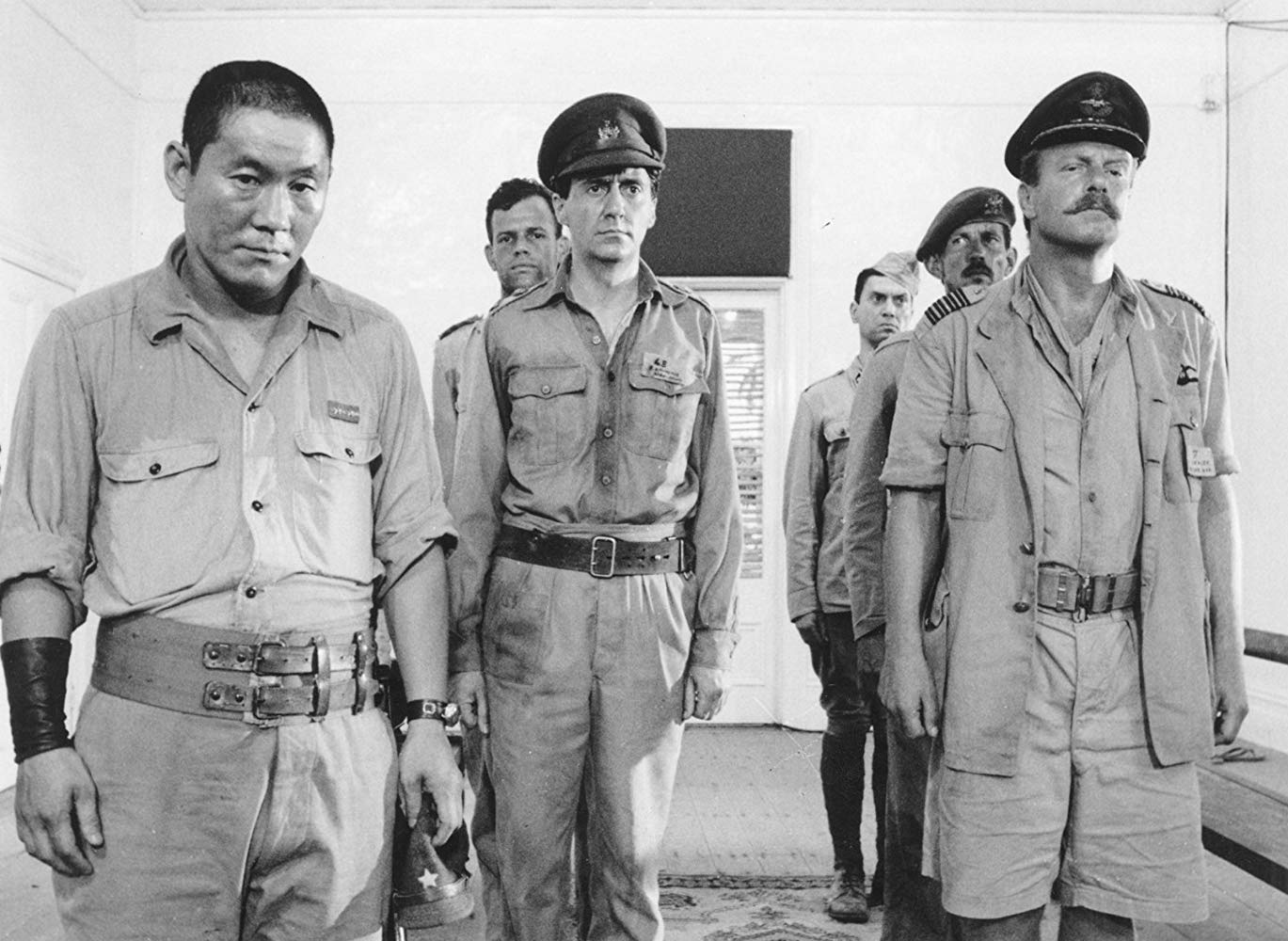
"Merry Christmas on the battlefield" stills
The Japanese army as rulers and the British army as captives were subdivided not only by ethnicity and nationality, but also by military rank and class of birth, and they were in a close correspondence with each other. Yu Yejing, a young lieutenant of the Japanese army, did not participate in the "2.26 Mutiny" because of his timidity, and felt guilty for his behavior of breaking away from the collective. The officer Yuan (played by Kitano Takeshi), who climbed up from the bottom, was born as a rough child from a poor farmer's family. He lacks upbringing and behaves violently, but occasionally unexpectedly reveals a cunning side of humanity. On the side of the British Army, Major Celias was born in the upper class and has aristocratic reserve, but because he abandoned his disabled younger brother in college, he has always had a strong sense of guilt in his heart. Lawrence (Tom Conti), the South African squadron leader who understands Japanese, served as the translator between Japan and Britain, so he also participated in the entanglement of the three.
There is a deep soul connection between the two protagonists. The comrades executed in the "February 26" incident of Yu Yejing, and the physically disabled younger brother of Celiers, are the cursed doppelgängers hidden in the shadow of the two people's daily rational consciousness, and they also form the basis of the other people's lives. The shadows in the depths of the soul that cannot be touched. Although there was only a brief intersection, the two people resonated in the depths of their souls and realized this resonance in the form of execution.
The Paper: In 1999, the last work directed by Nagisa Oshima, starring Takeshi Kitano, was released, with music by Ryuichi Sakamoto. His cooperation with Takeshi Kitano and Ryu Sakamoto lasted for thirty years, and what impact did it have on Japanese filmmakers and even the international film industry?

"Royal Law" stills. Takeshi Kitano as Kondo and Hijikata
Zhi Fina: I think there are three aspects of Nagisa Oshima's influence on Japanese films, not limited to Takeshi Kitano and Ryuichi Sakamoto. Nagisa Oshima has played an unprecedented role in connecting the past and the future in the Japanese film creation circle.
First, the new wave movement set off by directors represented by Nagisa Oshima and Shohei Imamura, another master, overcame difficulties for the development of Japanese film art. Nagisa Oshima, as a pioneer of modern Japanese film art, used images to construct a bold expression of sex and an obsession with aesthetics of violence, especially his appeal to society and politics. He and his allies shaped the development of Japanese films later. .

"Night and Fog in Japan" poster
Second, Nagisa Oshima and his allies set off a wave of independent production, rebelling against the big studio system. He has carried out the attitude of not cooperating with big studios all his life. In October 1960, Oshima Nagisa created "Night and Fog in Japan" based on the student movement experience. The film takes the anti-Japanese-US security treaty movement as the stage, takes a grand wedding as the scene, and outlines the reflections of two generations on the democratic movement through the debates that almost confront each other. attitude, a sharp satire of extreme Stalinism. Due to political incidents, the film was suspended by Shochiku Company within four days after it was released as "a tribute to the left wing".
In June 1961, Nagisa Oshima fired Shochiku after simply paying a liquidated damages. After Oshima Nagisa left, Shochiku’s other two New Wave banner figures, Yoshida Kishige and Shinoda Masahiro, followed suit, established their own independent production companies, and “abducted” Okada Moliko, who was very popular with the audience. And Iwashita Shima. It can be said that Shochiku lost a lot, and lost three talented young directors and three popular young actresses at once.
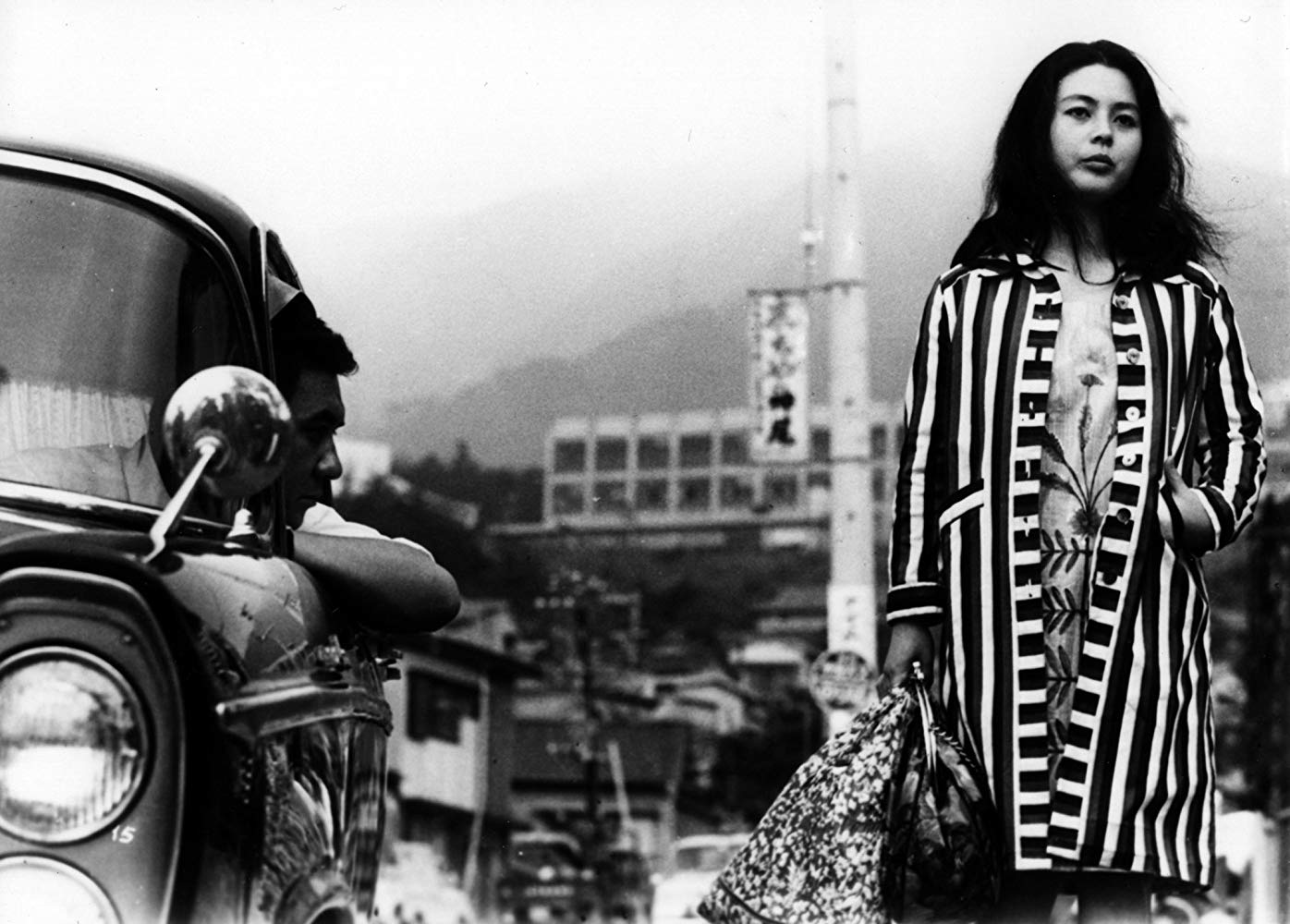
"Day Devil" stills

Stills of "Diary of a Shinjuku Thief"
Third, Nagisa Oshima promoted the diversification and internationalization of Japanese filmmakers. In addition to the far-reaching influence of his own works in the world, there are three representative figures, whose significance can be seen.
One is the director Takeshi Kitano who is not a major. Takeshi Kitano once said, "It was Nagisa Oshima who taught me how great it is to be a director." Nagisa Oshima's aesthetic style of violence is reflected in many of his films.
The second is Cui Yangyi, the second generation of Koreans living in Japan. When Nagisa Oshima served as the president of the Japan Directors Association, he predicted in the TV feature film "One Hundred Years of Japanese Film" produced in 1995 that the appearance of Cui Yangichi would definitely bring about great changes in Japanese film. As he said, Cui Yangichi, who was the deputy director of "The Kingdom of the Senses" and appeared as the chairman of the Japan Directors Association, was very active in diversifying themes and supporting foreign directors.
The third is Ryuichi Sakamoto. At that time, he was only famous in Japan. After he starred in "Merry Christmas on the Battlefield", he received wide international attention. That's why he was later invited to work in "The Last Emperor" and became a composer of international attention. Even so, Nagisa Oshima and Akiko Koyama did not regard themselves as masters, and they were very polite and respectful to these junior directors, saying that they were able to cooperate because of "the same artistic concept".
The Paper: "Yu Fa Du" was released in 1999. This costume film is adapted from Shiba Ryotaro's short story collection "Shinsengumi Blood Wind Record". It takes Kyoto in the late Bakumatsu period as the main scene, and takes the gay men in Shinsengumi as the perspective. In your opinion, why did he return to Japanese local themes in his last work?
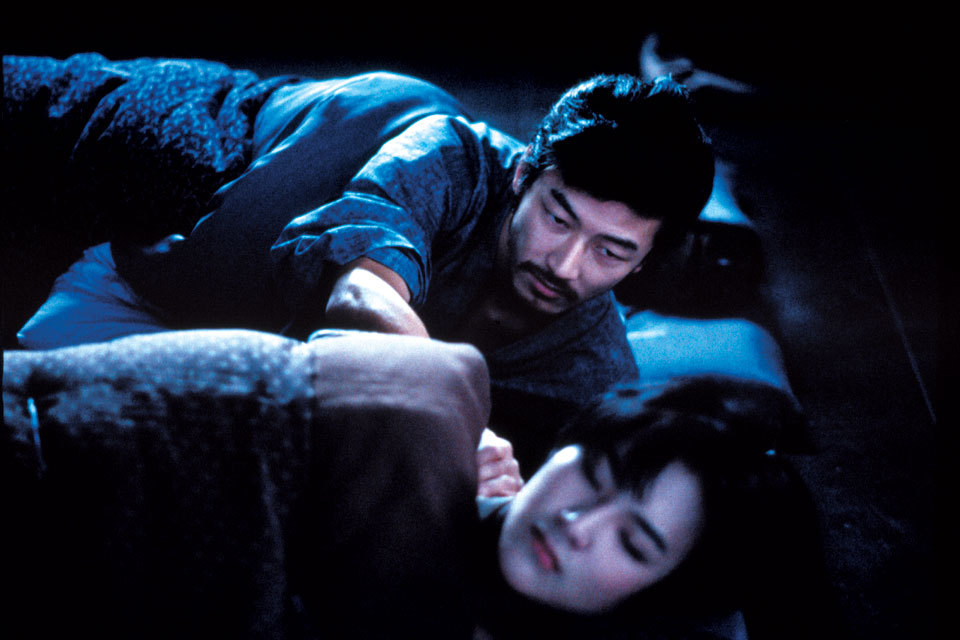
Stills of "Royal Law"
Zhi Fina: In "Royal Code", the Shinsengumi, the so-called law enforcement agency strictly organized by the rules of "law in the bureau" and "law in the army", is nothing but a gorgeous myth of lust and wanton killing. I think this is also a masterpiece that deals with reality and uses the past to satirize the present.
Shifang Tian Inuhiko believes that the meaningfulness of the movie "Godhodo" lies in the fact that it is a wonderful return to the theme in Nagisa Oshima. The film is based on the premise of the same-sex social atmosphere shrouded in the terrorist organization Shinsengumi at the end of the Bakumatsu period, expressing homophobia that has never appeared in Nagisa Oshima's works so far. It is a story of the self-defense of the community formed by the tacit understanding of patricide in the original state.
Shinsengumi is a database of classic themes of Japanese costume films. However, Nagisa Oshima broke the narrative pattern of previous Shinsengumi themes, and set the Shinsengumi group composed of two generations as a community of lust. In "Yufadu", there is no stable order to support the community at all, and the structure of the order itself is changeable. The so-called "Yufadu" order was morbidly activated by the beautiful boy invaders from outside, and it became a pile of waste paper the moment it built various oppositions.
"Drinking Unlimited Layman" who Criticizes Current Malpractice
The Paper: Now that I mentioned Nagisa Oshima's TV documentaries, I noticed that he was also active as a TV commentator after the 1980s. I have no chance to see this aspect, can you introduce one or two?
Zhi Fina: Since 1973, he has hosted TV talk shows for nearly 20 years. He often wears a colorful men's kimono and shouts angrily on TV: "No way! Not allowed!"
At a Japanese-Korean seminar, he yelled at some Korean participants who only talked about nationalism, "You bastard!"
He even had a big fight with the famous writer Nosaka Akira at his "Pearl Wedding" (thirty years after marriage) party, hitting Nosaka's old face with a microphone. Of course, the two of them were genuine, and they apologized to each other afterwards, reconciled, and still got along happily. Moreover, Nosaka Akira also had a stroke later, so the two wives often exchanged nursing experiences.
There are two Japanese directors that I am afraid of. One is Nagisa Oshima and the other is Takeshi Kitano. They are both quite vicious and merciless. I was once thankful that Nagisa Oshima could no longer accept interviews when I was in Japan. I was afraid that I would be stunned and scolded when I faced him. In contrast, Akiko Koyama is too gentle.
The Paper: What is Nagisa Oshima's personality like on set?
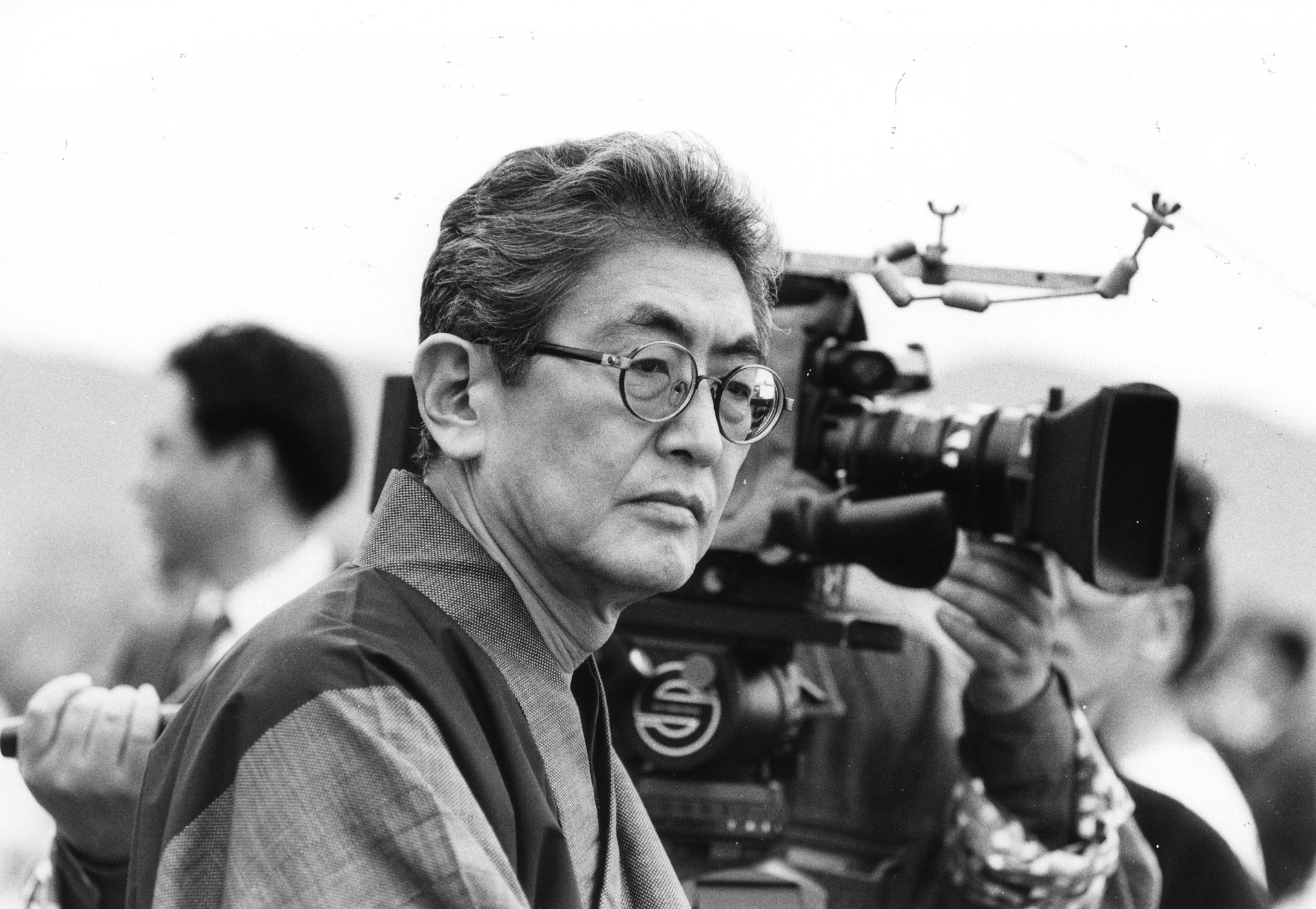
Nagisa Oshima on set
Zhi Fina: In fact, Nagisa Oshima is a persuasive type at the scene. When Takeshi Oshima was asked by Nagisa Oshima to film "Merry Christmas on the Battlefield", he was a little puzzled. He was just a cross talk actor at the time, not to mention Nagisa Oshima's movies, and he had never seen anyone's movies. He bit the bullet and went to the scene, and saw Ryuichi Sakamoto who was as confused about acting as he was. At that time, Ryuichi Sakamoto was already a well-known musician in Japan. Kitano Takeshi and Sakamoto Ryuichi discussed, since they don't rely on acting for a living anyway, if he curses, they will quit.
"Who knows that he has always been polite to us, scolding the assistant director whenever we can't perform well." There was a scene where Takeshi Kitano didn't perform well, and several reshoots were made. Finally, Nagisa Oshima became angry and pointed at the director with the guide tube. Looking at a lizard next to Takeshi Kitano, he yelled: "Hey, Wuna Lizard, which agency are you from? Can't you crawl well? You can't even act well!"

Ryuichi Sakamoto
The Paper: On January 15, 2013 (Heisei 25), Oshima Nagisa died of pneumonia in a hospital in Fujisawa City, Kanagawa Prefecture, at the age of 80. After his death, he was buried in Huichun Temple of Kenchoji Temple in Kamakura City. Did the director like to drink alcohol?
Zhi Feina: Haha, it doesn't mean "drinking often and unlimited". During his lifetime, Nagisa Oshima liked to point out the current malpractices, and he often “screamed loudly” about the dark side of Japanese society and Japanese history, exposing and criticizing them mercilessly. So his precept name is "Drinking Unlimited Layman". Shikata Inuhiko commented that regarding Japan, no matter what the occasion, Oshima Nagisa is an out-and-out critic and a great scolder.
Nagisa Oshima also mercilessly scolded the old director who stuck to the rules. Masa Imai and Nagisa Oshima, the famous directors of "Blue Mountain" and "Tower of Shandan", which are familiar to the older generation of Chinese audiences, even wrote "Masa Imai Stinky Shit Talk". He also said, "I want to drive away all the old things that I don't like." As a core figure of the New Wave, he saw some low-level films also in the name of the "New Wave". Published "Fight the "New Wave"!" "'s radical article, calling it a "new wave of bullshit." He also shows no mercy to some directors of the same generation who are always unwilling to make progress.
Change the outdated concept of film with "Rage-like Attack"
The Paper: I noticed that on December 4, 2019, Nagisa Oshima's widow, Akiko Koyama, and PIA Film Festival Director Hiroshi Yanai held a press conference at the Japan Association of Foreign Correspondents to announce the creation of the Nagisa Oshima Award. With Ryuichi Sakamoto as the Chief Examiner and Kiyoshi Kurosawa and Keiko Araki as the Examiner Committee members, directors who live in Japan and have directed and screened at least three films will be selected for selection. Talk about the award and the story of contact with the director's widow.
Zhi Fina: Nagisa Oshima loves young talents all his life. He called for a "storm-like attack" to change the outdated concept of film. He has always actively supported the aesthetic possibilities and strong personalities of young people in independent productions. Nagisa Oshima was the fifth chairman of the Japan Film Directors Association. He served for a total of 16 years until he fell ill in 1996. He was one of the two directors with the longest tenure in the history of the association. Since the Japanese Independent Film Festival PFF (also known as PIA) first set up the awards unit in 1979, Oshima Nagisa has served as a judge for many sessions (1979-1988, 1992), so he claims to be "the whole Japan to watch independent films". Directors with the Most Numbers", selected Kazushin Inudou, Makoto Tezuka (son of Osamu Tezuka), Kiyoshi Kurosawa, Joji Matsuoka, Tetsuya Nakajima, Akihiko Shiota, Atsuhiko Suwa, Onko Sonoko, Ide Narushima, Ryosuke Hashiguchi , Shinya Tsukamoto, Tomoyuki Gustable and other later mainstays.

The scene of the first "Oshima Nagisa Award" in 2020
The "Oshima Nagisa Award" is specially awarded to young directors with a sense of innovation, and it adheres to the principle of preferring lack over excess, and sometimes it will be vacant. There are only three awards named after directors in the Japanese film industry. One is the "Kurosawa Akira Award" at the Tokyo International Film Festival, the other is the "Oto Noburo Award" in the animation film industry, and the other is the "Oshima Nagisa Award".
The Paper: Can you introduce your relationship with Nagisa Oshima's partner Akiko Koyama?
Zhi Feina: Akiko Koyama made her debut earlier than Nagisa Oshima. At that time, she was the head of the Shochiku company. As early as 1959, she visited Germany on behalf of Japan as a first-line actress, while Nagisa Oshima was just an inconspicuous assistant director next to Yasujiro Ozu. . After Oshima Nagisa fired the company, he also abducted the leading actress.
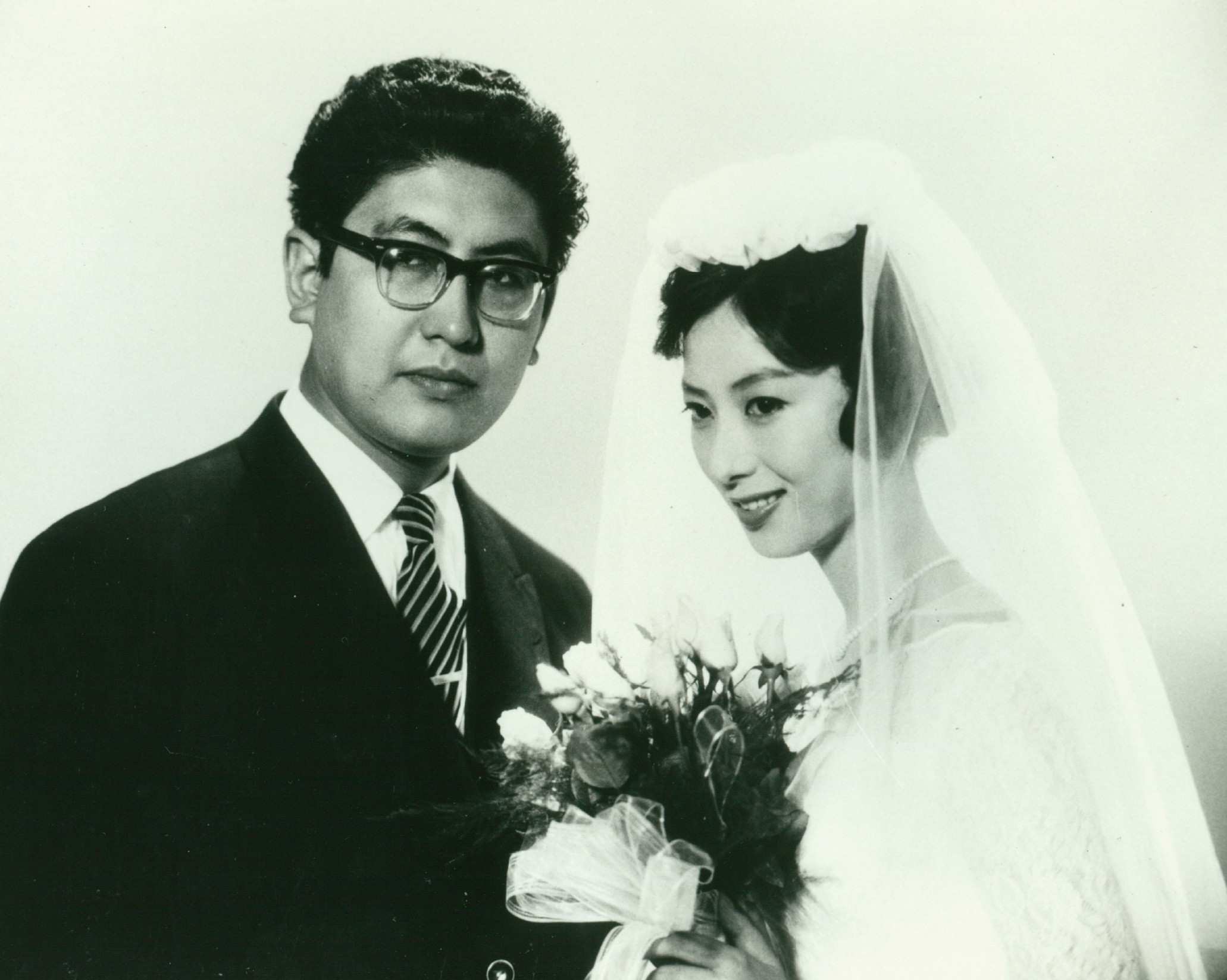


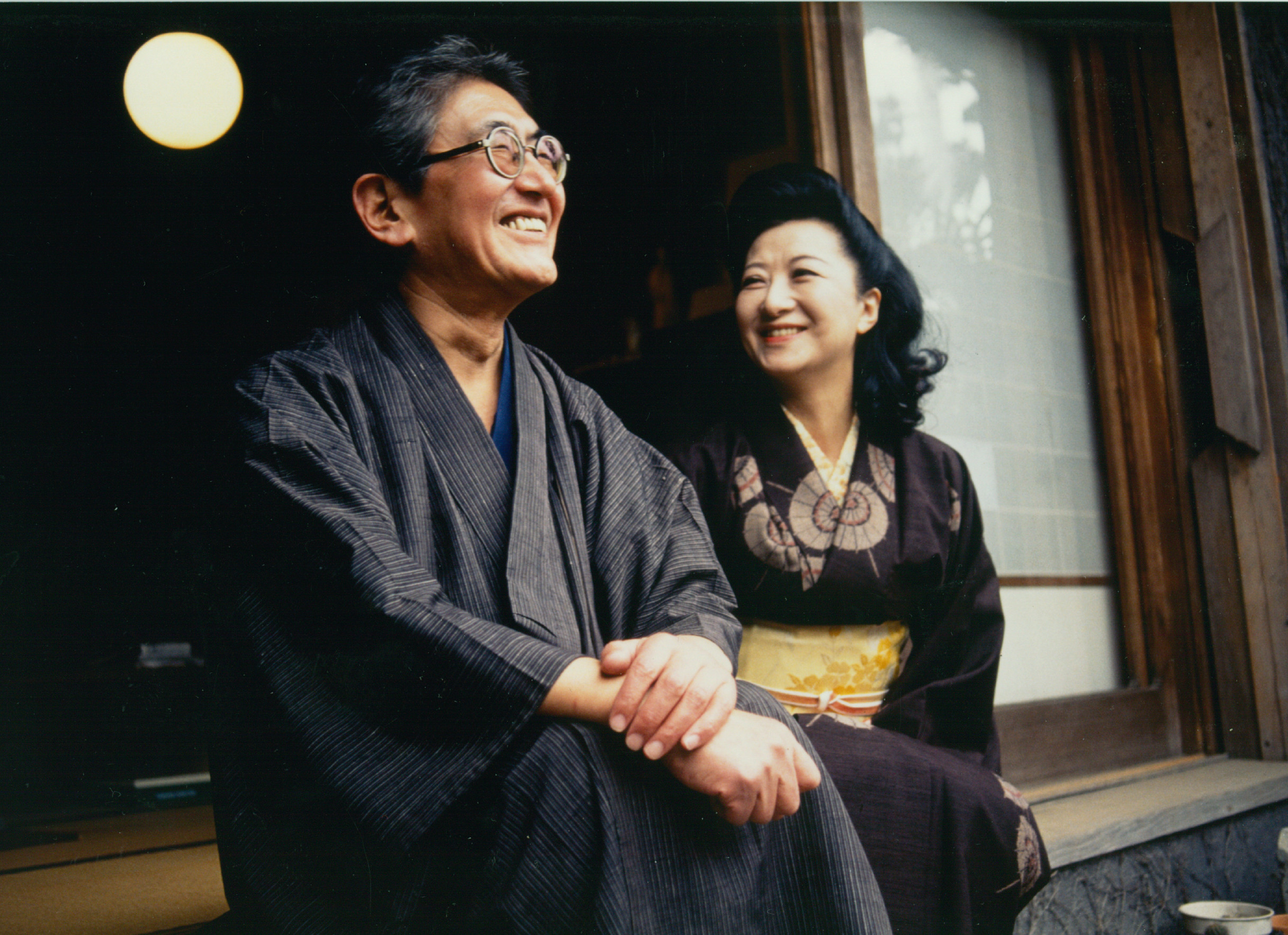
Group photos of Nagisa Oshima and Akiko Koyama at different times (photo provided by Akiko Koyama)
In this way, Akiko Koyama violated the regulations of the five major Japanese film companies at that time, and could no longer act in the films of major companies. Nagisa Oshima's film studio was facing serious financial difficulties. Akiko Koyama not only acted as the heroine and screenwriter in her works, but also went to the TV station to shoot some commercials when she had no roles, and the money she earned was immediately invested in the operation of the crew. After Nagisa Oshima fell ill, she took care of her for a long time, which caused her to suffer from depression twice, and eventually she gradually came out. She is a very powerful woman.
Akiko Koyama serialized her life story in newspapers for a while. My landlord in Japan, a famous Japanese historian and expert on China, Tadaki Murata, found me these newspapers and told me that Akiko Koyama would give a speech in my town in two weeks. On the same day, I took the newspaper and went to the backstage to find Akiko Koyama. She was very happy that there were Chinese scholars who came to listen, and she also saw my sincerity. Later, she invited me and the producer of "Merry Christmas on the Battlefield" Motochi Masayuki to meet and interview, and told a lot about Nagisa Oshima's past.

"Oshima Nagisa and Japan" (written by Sifang Tian Inuhiko, translated by Zhi Feina, published by Peking University Press in January 2022)
The Paper: In January last year, "Oshima Nagisa and Japan" (written by Sifang Tian Inuhiko, translated by Zhi Feina, Peking University Press) was published. As a translator, please talk about the translation and introduction process of this book and the highlights of the book?
Zhi Fina: I have known Professor Shikata Inuhiko since 2004. In 2010, I talked to him about translating his book "Oshima Nagisa and Japan" to China. He readily agreed. After Peking University Press found me, Professor Shikata Inuhiko accompanied the famous stage artist Yoshito Ohno to Beijing in 2017. We settled the matter with the three parties, and after contacting the Japanese copyright, we began to write.
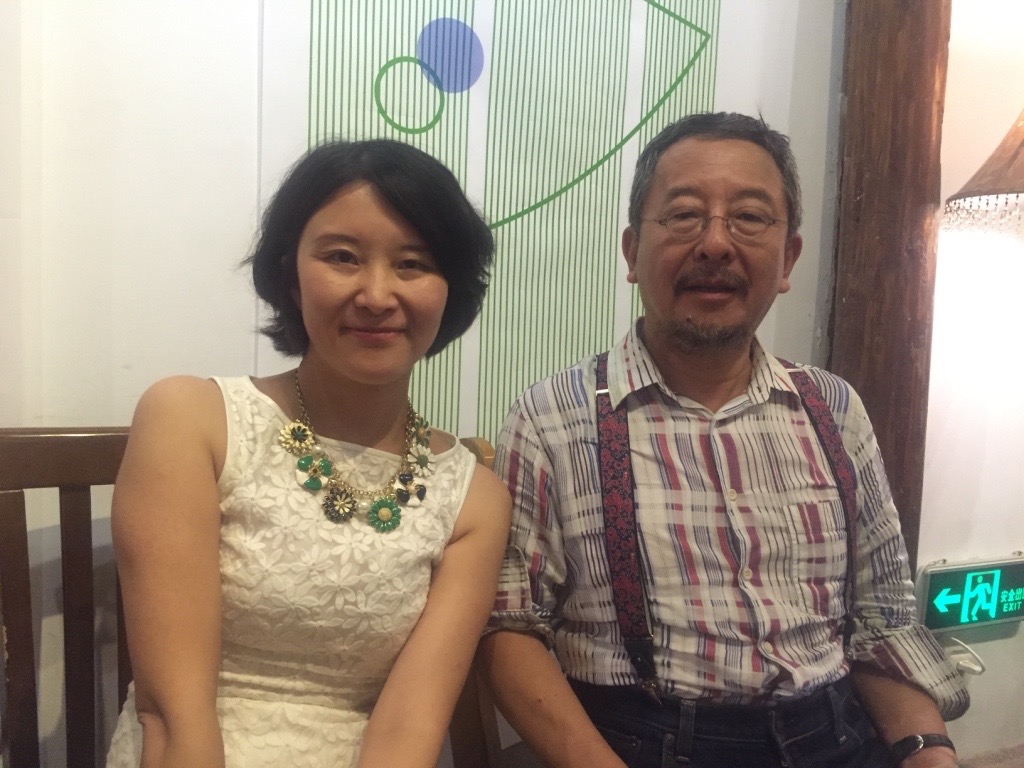
In 2017, Beijing Penghao Theater, Zhi Feina and Sifang Tian Inuhiko
After the draft was completed in May 2018, it underwent several rounds of revisions. Affected by the epidemic, the publication of this book stagnated for some time, but it finally came out in January 2022, and received strong support and praise from Nagisa Oshima's family. After the Chinese version came out, Shikata Inuhiko said that he was more happy about Nagisa Oshima's spirit in heaven than himself. Because no matter whether Nagisa Oshima was working as a director in Tokyo or Paris, he always took China at that time into his field of vision for film practice.
The first highlight of this book is that the original author is probably the best interpreter of Nagisa Oshima's works. Shifang Tian Inuhiko is the editor of the four-volume "Oshima Nagisa Works Collection", and he is the most familiar scholar with Oshima Nagisa. In the book, Mr. Sifangtian abandons the traditional Japanese literary theory and adopts the scalpel of Western literary theory to analyze in detail the works of Nagisa Oshima, a representative Japanese director, so as to clarify the relationship between Nagisa Oshima and Japan. As far as I personally read it, I deeply feel that "Oshima Nagisa and Japan" is an indispensable and important reference for understanding Oshima Nagisa and its era. But I am also slightly worried: even for Oshima Nagisa, a genius who is well versed in Western culture, whether this attempt to apply Western literary theory to Oshima Nagisa may surpass the creator's own creation original intention and insight.
After the book was published, many people commented that this book has no translation accent, and the text is relatively smooth and compact. This is probably the second highlight of this book. I think it is because of my nearly 10 years of work experience in the central ministries and commissions and national ministries and commissions, I have developed good writing skills, I don't talk much nonsense, and I am relatively familiar with Nagisa Oshima. Generally speaking, the translation process is relatively smooth. But my weakness is my lack of Japanese and literature. Fortunately, this book is not difficult in general. Sifang Tian Inuhiko's writing is more scholarly and casual. After 2015, I focused on the policy of China's film industry. I did less and less research on Japanese films, and I didn't have the energy to do translation. But the related research and translation of Nagisa Oshima is my long-cherished wish.
The Paper: Mr. Ni Zhen passed away due to the new crown at the end of last year. I looked at the photo album of Mr. Oshima. He met Nagisa Oshima once. Is there any past events that can be recalled?
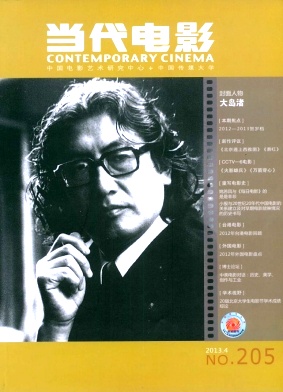
April 2013 cover of Contemporary Cinema
Zhi Fina: When I heard the news of Nagisa Oshima's death, I contacted the academic magazine "Contemporary Cinema" immediately, and agreed to introduce Nagisa Oshima in its cover character column. I chose a photo of his very artist style as the cover of "Contemporary Cinema" in April 2013. The editorial department asked Professor Ni Zhen to write a commemorative manuscript, and I wrote a conclusive academic article "Rebellious Acts, Temperament, Samurai Heart-Mourning Film Master Nagisa Oshima", and sorted out his His life was published together in the current issue of the magazine.
The Chinese film industry has quite a lot of contact with Nagisa Oshima. Director Chen Kaige once had a conversation with Nagisa Oshima during the screening of "Yellow Earth" in the 1980s. Teacher Ni Zhen met Nagisa Oshima in 2000. In addition, teacher Zheng Yaling from Beijing Film Academy also interviewed Nagisa Oshima.
Teacher Ni Zhen has the cultivation of a scholarly family in Jiangsu and Zhejiang, the elegance of a high-level intellectual, and the temperament of an artist. I think the two most handsome male teachers at the Beijing Film Academy at that time were Ni Zhen and Wang Liu from the Department of Literature. Even in the face of a student like me, he will always say "you", and write letters to me when he has business. When he passed away, half of the film industry went to see him off, partly because of his artistic achievements, partly because of his personality. Mr. Ni Zhen had an Asian perspective earlier than most film scholars, and he cared about his contacts with the Japanese art world. I think that's why he kept in touch with me and helped me grow.
In fact, Mr. Ni Zhen and director Nagisa Oshima have very similar temperaments, and they are both old-school cultural people. Nagisa Oshima must wear a kimono when attending overseas international film festivals. And no matter how late he came home from filming, he would kneel and sit outside his mother's door to say hello. Although he has made so many shocking films, he and Akiko Xiaoshan are very affectionate. Xiaoshan told me that he has never heard of her husband's scandal.
